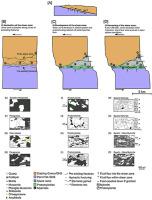当前位置:
X-MOL 学术
›
J. Struct. Geol.
›
论文详情
Our official English website, www.x-mol.net, welcomes your feedback! (Note: you will need to create a separate account there.)
Role of fluid in strain softening within the Main Central thrust in Sikkim: The origin of quartz-rich mylonites
Journal of Structural Geology ( IF 3.1 ) Pub Date : 2020-11-01 , DOI: 10.1016/j.jsg.2020.104145 Sayantan Chakraborty , Alik S. Majumdar , Anil D. Shukla
Journal of Structural Geology ( IF 3.1 ) Pub Date : 2020-11-01 , DOI: 10.1016/j.jsg.2020.104145 Sayantan Chakraborty , Alik S. Majumdar , Anil D. Shukla

|
Abstract The presence of fluids promotes strain softening, and profoundly affects the evolution of shear zones. The Main Central thrust (MCT) is a major shear zone that accommodated at least 90 km of shortening, and played a significant role in Cenozoic evolution of the Himalaya. Surprisingly, no information exists on the role of fluid in evolution of the MCT. This study integrates mineralogical, and geochemical analyses with mass-balance calculations to explore the role of fluids in evolution of the MCT shear zone from four exposures, which span ∼40 km distance along the transport direction in Sikkim, eastern India. Our analyses reveal significant fluid-induced strain softening in the investigated exposures, attested by retrogression of biotite to chlorite, and feldspar to muscovite, and quartz. The retrogressed feldspar grains are surrounded by recrystallized quartz, and the muscovite, and chlorite produced due to retrogression define the mylonite foliations, which indicate fluid activity was syn-tectonic. We propose a three-stage conceptual model to analyze the role of fluid in the evolution of the MCT in Sikkim: First, the shear zone nucleated along pre-existing structurally weak, and compositionally distinct zones. Following which, the proto shear zone developed in closed-system conditions, and deformation localized by dynamic recrystallization, and dislocation creep resulting in formation of ∼200–1000 m-thick protomylonites. Then, fluids infiltrated the shear zone, and induced retrogression, and element mobility. In the hinterland-most exposures, significant fluid-induced retrogression transformed the calc-silicate and paragneiss protoliths to mylonites resembling micaceous quartzites. In the frontal-most, and structurally intermediate exposures, the muscovite and chlorite grains underwent further dissolution, leaving behind a quartz-rich residue; thus, transforming tonalite orthogneiss, and paragneiss protoliths to mylonites resembling monomineralic quartzites. The deformation front narrowed through time, and became progressively localized within the ∼120-410 m-thick strain-softened mylonites at the shear zone core, whereas, deformation ceased or continued slowly in the ∼100-880 m-thick protomylonites at the margins. The study improves our understanding of the strain softening mechanisms operative within the MCT, and the origin of quartz-rich mylonites.
中文翻译:

流体在锡金主冲断层应变软化中的作用:富含石英的糜棱岩的起源
摘要 流体的存在促进了应变软化,并深刻影响了剪切带的演化。中央主冲断层(MCT)是一个主要剪切带,至少容纳了 90 公里的缩短,在喜马拉雅山的新生代演化中发挥了重要作用。令人惊讶的是,没有关于流体在 MCT 演化中的作用的信息。这项研究将矿物学和地球化学分析与质量平衡计算相结合,以探索流体在四个暴露点的 MCT 剪切带演化中的作用,这些暴露点沿着印度东部锡金的运输方向跨越约 40 公里的距离。我们的分析揭示了在所研究的暴露中显着的流体诱导的应变软化,这通过黑云母退化为绿泥石、长石退化为白云母和石英来证明。退化的长石颗粒被重结晶的石英包围,由于退化产生的白云母和绿泥石定义了糜棱岩叶理,表明流体活动是同构造的。我们提出了一个三阶段概念模型来分析流体在锡金 MCT 演化中的作用:首先,剪切带沿着预先存在的结构薄弱且成分不同的区域成核。此后,原始剪切带在封闭系统条件下发展,动态再结晶和位错蠕变导致局部变形,形成约 200-1000 m 厚的原裂板岩。然后,流体渗入剪切带,并引起倒退和元素移动。在腹地-最暴露,显着的流体引起的倒退将钙硅酸盐和副片麻岩原岩转变为类似云母石英岩的糜棱岩。在最正面和结构中间的暴露中,白云母和绿泥石颗粒进一步溶解,留下富含石英的残留物;因此,将方麻岩和副片麻岩原岩转化为类似单矿物石英岩的糜棱岩。变形前沿随着时间的推移逐渐变窄,并逐渐集中在剪切带核心处约 120-410 m 厚的应变软化糜棱岩内,而在边缘处约 100-880 m 厚的原糜棱岩中变形停止或继续缓慢. 该研究提高了我们对 MCT 中起作用的应变软化机制以及富含石英的糜棱岩起源的理解。
更新日期:2020-11-01
中文翻译:

流体在锡金主冲断层应变软化中的作用:富含石英的糜棱岩的起源
摘要 流体的存在促进了应变软化,并深刻影响了剪切带的演化。中央主冲断层(MCT)是一个主要剪切带,至少容纳了 90 公里的缩短,在喜马拉雅山的新生代演化中发挥了重要作用。令人惊讶的是,没有关于流体在 MCT 演化中的作用的信息。这项研究将矿物学和地球化学分析与质量平衡计算相结合,以探索流体在四个暴露点的 MCT 剪切带演化中的作用,这些暴露点沿着印度东部锡金的运输方向跨越约 40 公里的距离。我们的分析揭示了在所研究的暴露中显着的流体诱导的应变软化,这通过黑云母退化为绿泥石、长石退化为白云母和石英来证明。退化的长石颗粒被重结晶的石英包围,由于退化产生的白云母和绿泥石定义了糜棱岩叶理,表明流体活动是同构造的。我们提出了一个三阶段概念模型来分析流体在锡金 MCT 演化中的作用:首先,剪切带沿着预先存在的结构薄弱且成分不同的区域成核。此后,原始剪切带在封闭系统条件下发展,动态再结晶和位错蠕变导致局部变形,形成约 200-1000 m 厚的原裂板岩。然后,流体渗入剪切带,并引起倒退和元素移动。在腹地-最暴露,显着的流体引起的倒退将钙硅酸盐和副片麻岩原岩转变为类似云母石英岩的糜棱岩。在最正面和结构中间的暴露中,白云母和绿泥石颗粒进一步溶解,留下富含石英的残留物;因此,将方麻岩和副片麻岩原岩转化为类似单矿物石英岩的糜棱岩。变形前沿随着时间的推移逐渐变窄,并逐渐集中在剪切带核心处约 120-410 m 厚的应变软化糜棱岩内,而在边缘处约 100-880 m 厚的原糜棱岩中变形停止或继续缓慢. 该研究提高了我们对 MCT 中起作用的应变软化机制以及富含石英的糜棱岩起源的理解。

























 京公网安备 11010802027423号
京公网安备 11010802027423号